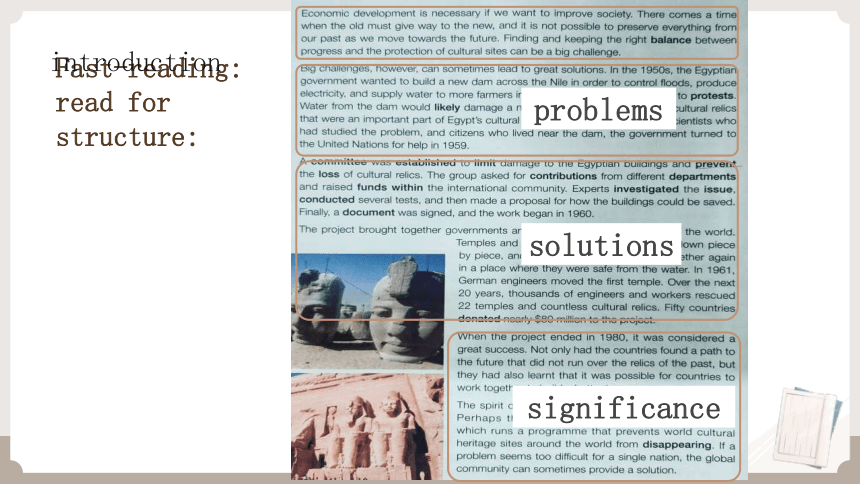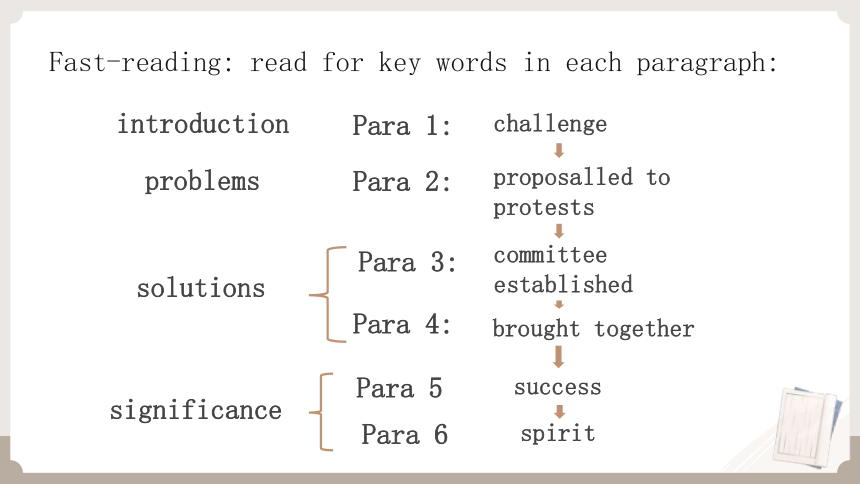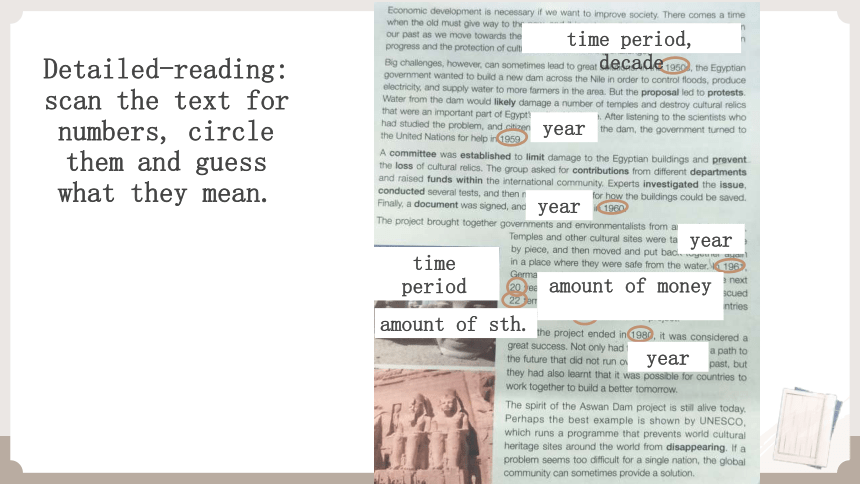人教版(2019)必修 第二册Unit 1 Cultural Heritage Reading and Thinking 1 课件(共19张PPT)
文档属性
| 名称 | 人教版(2019)必修 第二册Unit 1 Cultural Heritage Reading and Thinking 1 课件(共19张PPT) |  | |
| 格式 | pptx | ||
| 文件大小 | 10.7MB | ||
| 资源类型 | 教案 | ||
| 版本资源 | 人教版(2019) | ||
| 科目 | 英语 | ||
| 更新时间 | 2025-03-03 10:16:02 | ||
图片预览







文档简介
(共19张PPT)
Unit 1 Cultural Heritage
Lesson 2 Reading and Thinking(1)
高一—人教版—英语—必修第二册
Teaching Aims:
After the class,students can:
understand the problems Egypt faced and how it worked out the solutions.
learn how to use a timeline and mind maps to analyse a reading text.
understand the significance of international cooperation in terms of cultural heritage protection.
Look at the pictures. What are they
Which country do they belong to
Pyramids
Sphinx
Abu Simbel Temple
Lead-in
Read the title and look at the photos.
What do you think the text is about
According to the title, what aspects might be talked about in the passage
(introduction of the problem, analysis of the problem, procedure of solving the problem, result, significance...)
Predicting
problems
solutions
significance
Fast-reading:
read for structure:
introduction
Para 1:
introduction
challenge
problems
Para 2:
proposalled to protests
Para 3:
committee established
solutions
Para 4:
brought together
significance
success
Para 5
Para 6
spirit
Fast-reading: read for key words in each paragraph:
time period, decade
year
year
year
time period
amount of sth.
amount of money
year
Detailed-reading:
scan the text for numbers, circle them and guess what they mean.
in the 1950s
in 1959
in 1960
in 1961
over the next 20 years
in 1980
The project ________________.
The temples and cultural relics were __________________.
_______ _________ moved the first temple.
The project _______.
The govern-ment asked
______ for help. A committee was established.
The _________ ____________ wanted to build a new dam.
The proposal led to _______.
reasons:
to control ______
_____________________
to supply water to _______
reasons:water
would likely damage ______
and destroy
______________
Egyptian
government
floods
to produce electricity
farmers
protests
temples
cultural relics
the UN
started
German
engineers
being
rescued
was
completed
Solutions
Complete Mind Map 1
Problems
B
B
C
1960
C
C
1959
1961
over the next 20 years
1980
in the 1950s
In what order is the passage organized
What is the text type of the passage
in the order of time
a narrative text
give us a clear picture of how the events happen
give us a better understanding of how the events are connected to each other
see the time it takes for events to happen
Reading skill learning 1: how can a timeline help us while reading
figures
in para.4
22 temples
fifty countries
$80 million
20 years
Think: What do these figures show us
It took a long time to finish the project.The project was so hard and cost a lot of money.
A lot of money was spent to protect the temples. Do you think it was worthwhile Why or why not
Yes.Because their value is priceless as cultural heritage.
thousands of
countless cultural relics
Complete Mind Map 2: focus on figures
To ensure the success of the project, how many departments participated in it What did they do
the success of the project
The government turned to the UN for help.
A committee was established.
Experts investigated the issue and made a proposal.
Governments and environmentalists were brought together to carry out the project.
Think: Why do you think so many countries contributed funds and offered help to the Egyptian project
Because Egyptian history and relics are world-famous and are highly valued around the world as part of our shared cultural history.
Complete Mind Map 3: focus on verbs
Reading skill learning 2: how can we draw a mind map while reading
We can draw mind maps by using key words like time, figures and verbs.
Watch a video clip to understand further about the text.
Learn new words in the video clip first:
generate v.产生
hydroelectricity n.水力发电
industrialize v.使工业化
submerge v.淹没
irreplaceable adj.不能替代的
salvage v.抢救
dismantle v.拆散
reassemble v.重新聚集
Further thinking: discuss the questions below
in groups.
1. Why is the project a great success
2. How do you understand the sentence in the last paragraph“The spirit of the Aswan Dam project is still alive today”
Possible answers:
1. Why is the project a great success
It led people to find ways to focus on economic development without causing damage to cultural relics. It helped countries to learn to work together to protect our cultural heritage.
2. How do you understand the sentence in the last paragraph“The spirit of the Aswan Dam project is still alive today”
International cooperation and selfless contribution are still needed in cultural heritage protection.
We should face challenges positively.
We should seek for cooperation properly.
We should make every effort to find out the solutions when facing problems.
Summary: to solve problems better and have better solutions, we need to work together.
It is a big challenge to keep the ________ between progress and the ___________ of cultural sites.
However, big ___________ can sometimes lead to great solutions. In the 1950s, the _________ government wanted to build a new dam across the Nile, but the proposal led to ________. Thus, the government turned to ___________________ for help in 1959.
A committee was ____________ to help rescue the temples and cultural relics. In 1961, German __________ moved the first temple. Over the next 20 years, thousands of engineers and workers from all over the world ________ 22 temples and __________ cultural relics. When the project ended in 1980, it was considered a great __________.
It shows that the global ___________ can sometimes provide
a ________ to a problem that seems too difficult for a single nation.
balance
protection
challenges
Egyptian
protests
the United Nations
established
engineers
rescued
countless
success
community
solution
Fill in the blanks to complete the summary of the text.
1. Finish Exercise 5 on P5.
2. The passage has a good logic flow. How does the author achieve this Please analyse the passage and then answer the question.You can think from the following perspectives: (1) passage structure; (2) the connections between paragraphs; (3) the connections between sentences; (4) sentence building; (5) wording.
Homework
谢谢观看Thank you.
Unit 1 Cultural Heritage
Lesson 2 Reading and Thinking(1)
高一—人教版—英语—必修第二册
Teaching Aims:
After the class,students can:
understand the problems Egypt faced and how it worked out the solutions.
learn how to use a timeline and mind maps to analyse a reading text.
understand the significance of international cooperation in terms of cultural heritage protection.
Look at the pictures. What are they
Which country do they belong to
Pyramids
Sphinx
Abu Simbel Temple
Lead-in
Read the title and look at the photos.
What do you think the text is about
According to the title, what aspects might be talked about in the passage
(introduction of the problem, analysis of the problem, procedure of solving the problem, result, significance...)
Predicting
problems
solutions
significance
Fast-reading:
read for structure:
introduction
Para 1:
introduction
challenge
problems
Para 2:
proposalled to protests
Para 3:
committee established
solutions
Para 4:
brought together
significance
success
Para 5
Para 6
spirit
Fast-reading: read for key words in each paragraph:
time period, decade
year
year
year
time period
amount of sth.
amount of money
year
Detailed-reading:
scan the text for numbers, circle them and guess what they mean.
in the 1950s
in 1959
in 1960
in 1961
over the next 20 years
in 1980
The project ________________.
The temples and cultural relics were __________________.
_______ _________ moved the first temple.
The project _______.
The govern-ment asked
______ for help. A committee was established.
The _________ ____________ wanted to build a new dam.
The proposal led to _______.
reasons:
to control ______
_____________________
to supply water to _______
reasons:water
would likely damage ______
and destroy
______________
Egyptian
government
floods
to produce electricity
farmers
protests
temples
cultural relics
the UN
started
German
engineers
being
rescued
was
completed
Solutions
Complete Mind Map 1
Problems
B
B
C
1960
C
C
1959
1961
over the next 20 years
1980
in the 1950s
In what order is the passage organized
What is the text type of the passage
in the order of time
a narrative text
give us a clear picture of how the events happen
give us a better understanding of how the events are connected to each other
see the time it takes for events to happen
Reading skill learning 1: how can a timeline help us while reading
figures
in para.4
22 temples
fifty countries
$80 million
20 years
Think: What do these figures show us
It took a long time to finish the project.The project was so hard and cost a lot of money.
A lot of money was spent to protect the temples. Do you think it was worthwhile Why or why not
Yes.Because their value is priceless as cultural heritage.
thousands of
countless cultural relics
Complete Mind Map 2: focus on figures
To ensure the success of the project, how many departments participated in it What did they do
the success of the project
The government turned to the UN for help.
A committee was established.
Experts investigated the issue and made a proposal.
Governments and environmentalists were brought together to carry out the project.
Think: Why do you think so many countries contributed funds and offered help to the Egyptian project
Because Egyptian history and relics are world-famous and are highly valued around the world as part of our shared cultural history.
Complete Mind Map 3: focus on verbs
Reading skill learning 2: how can we draw a mind map while reading
We can draw mind maps by using key words like time, figures and verbs.
Watch a video clip to understand further about the text.
Learn new words in the video clip first:
generate v.产生
hydroelectricity n.水力发电
industrialize v.使工业化
submerge v.淹没
irreplaceable adj.不能替代的
salvage v.抢救
dismantle v.拆散
reassemble v.重新聚集
Further thinking: discuss the questions below
in groups.
1. Why is the project a great success
2. How do you understand the sentence in the last paragraph“The spirit of the Aswan Dam project is still alive today”
Possible answers:
1. Why is the project a great success
It led people to find ways to focus on economic development without causing damage to cultural relics. It helped countries to learn to work together to protect our cultural heritage.
2. How do you understand the sentence in the last paragraph“The spirit of the Aswan Dam project is still alive today”
International cooperation and selfless contribution are still needed in cultural heritage protection.
We should face challenges positively.
We should seek for cooperation properly.
We should make every effort to find out the solutions when facing problems.
Summary: to solve problems better and have better solutions, we need to work together.
It is a big challenge to keep the ________ between progress and the ___________ of cultural sites.
However, big ___________ can sometimes lead to great solutions. In the 1950s, the _________ government wanted to build a new dam across the Nile, but the proposal led to ________. Thus, the government turned to ___________________ for help in 1959.
A committee was ____________ to help rescue the temples and cultural relics. In 1961, German __________ moved the first temple. Over the next 20 years, thousands of engineers and workers from all over the world ________ 22 temples and __________ cultural relics. When the project ended in 1980, it was considered a great __________.
It shows that the global ___________ can sometimes provide
a ________ to a problem that seems too difficult for a single nation.
balance
protection
challenges
Egyptian
protests
the United Nations
established
engineers
rescued
countless
success
community
solution
Fill in the blanks to complete the summary of the text.
1. Finish Exercise 5 on P5.
2. The passage has a good logic flow. How does the author achieve this Please analyse the passage and then answer the question.You can think from the following perspectives: (1) passage structure; (2) the connections between paragraphs; (3) the connections between sentences; (4) sentence building; (5) wording.
Homework
谢谢观看Thank you.
